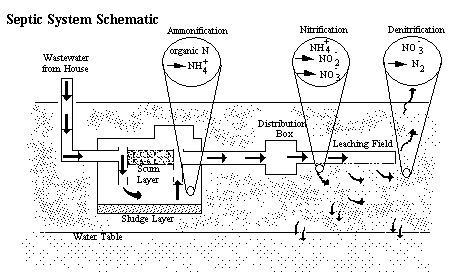ON-SITE WASTEWATER DISPOSAL
Septic Systems
![]() Wastewater from sinks, tubs, showers, dishwashers, clothes washers and toilets flows into the household septic system. The wastewater (averaging about 55 gallons per person per day according to Massachusetts Title 5 Sanitation Code) contains human waste products in addition to other solids, grease, dirt, chemicals, bacteria and viruses.
Wastewater from sinks, tubs, showers, dishwashers, clothes washers and toilets flows into the household septic system. The wastewater (averaging about 55 gallons per person per day according to Massachusetts Title 5 Sanitation Code) contains human waste products in addition to other solids, grease, dirt, chemicals, bacteria and viruses.
Wastewater enters the septic system where solids settle to the bottom in a sludge layer; grease floats on top as a scum layer. Liquids flow out to the distribution box and from there to the leach field. Bacteria play a major role in converting organic material within the septic system to ammonium and nitrate. These and other forms of nitrogen participate in the
nitrogen cycle.Fate of Nitrogen from Septic Systems
Some nitrogen is adsorbed to soil particles and does not enter groundwater; some is denitrified to nitrogen gas (N2) and escapes to the atmosphere. However, nitrate (NO3-) is very soluble in water and much of it travels with groundwater to a coastal embayment. In areas where there is no oxygen but there is organic matter, some nitrate can be converted to nitrogen gas. In the presence of oxygen, most of the ammonium (NH4+) is changed to nitrate.
